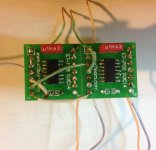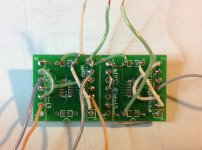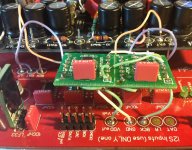im curious about this too can we get 400uA at 2.4v
out of the 2sk246 or do we have to get inventive?
it's relatively simple to get the single-2SK246 CCS to regulate 400uA - you adjust the setting resistor. But:
For it, though, to run properly at 2.4V (which coincides with Vdg), Vdg should well exceed 2*Vgs(off). Also, Id (=400uA) should be well under the Idss of the part used.
Both of the requirements above indeed restrict the 2SK246s to the Y selection group, and per data sheet (I welcome other thoughts on this), ideally further selected to an Idss under about 1.5mA (which renders a Vgs(off) under about 1.2V). This dials the CCS at an pretty optimum operating point.
(Also, after talking to Ross to clarify my question (#3085), the adjusting resistor he needed to use for the GR variety was really really high - about 4-4.5k - dropping too much voltage from the already diminutive 2.4V available. I guess that's why the selection of the part is so finicky; see paragraph above, and all other articles and papers quoted previously)
Radu.
Last edited:
it's simple to get the single-2SK246 CCS to regulate 400uA - you adjust the setting resistor. I'm not entirely sure Ross uses a setting resistor...
For it, though, to run properly at 2.4V (which coincides with Vdg), Vdg should well exceed 2*Vgs(off). Also, Id (=400uA) should be well under the Idss of the part used.
Both of the requirements above indeed restrict the 2SK246s to the Y selection group, and per data sheet (I welcome other thoughts on this), ideally further selected to an Idss under about 1.5mA (which renders a Vgs(off) under about 1.2V). This dials the CCS at an optimum operating point.
Radu.
wasnt aware of the y version, ive just ordered some and some 2sk170's for comparisons
hopefully all will go well
Just ordered six of the 2SK246Ys from an EBAY seller in the UK.
If I have more than two usable ones I will offer them to any in the US who might want them..
THANKS carlsor and RAX for your investigations!
If I have more than two usable ones I will offer them to any in the US who might want them..
THANKS carlsor and RAX for your investigations!
Well now! After a couple of changes, we had a little listening session last night, and it's sounding really very good indeed now.
Just to recap, I'm currently running e-301 current regulator diodes to pin 20, and I've been investigating running a jfet buffer stage inbetween my single deck pos/neg outputs and a pair of Cinemag output transformers.
I've installed switches, so I can instantly change the output from 'dddac > buffer > cinemags' to 'dddac > cinemags' so I can do some proper comparative listening.
My first impressions once the buffer stage had time to burn in and settle down were mostly positive, but not entirely. The sound was chunky, bold and luscious, but on certain recordings there was an additional ghosting which sounded almost like a very slight chorus effect. I wasn't happy that this was originally in the recording and felt that the buffer had added something, which kind of put me off it a bit.
I've been chatting with Ross who's been incredibly helpful and having found specific sections of music that seemed to excite this behaviour, he dug his scope out and began breaking the issue down. Square wave signal into the buffer gave square wave out of the buffer, but not so with the cinemags, where the same signal exited looking quite scruffy.
Ross tried a small film capacitor across the output of the Cinemags and this cleaned the signal up very nicely, but go too large and it effected the music.
I joined in on this with a 220pf Polystyrene cap across my RCAs (as that's what I had to hand), which I have again installed with switches, so I can compare.
Here's a couple of pics of where I'm up to:
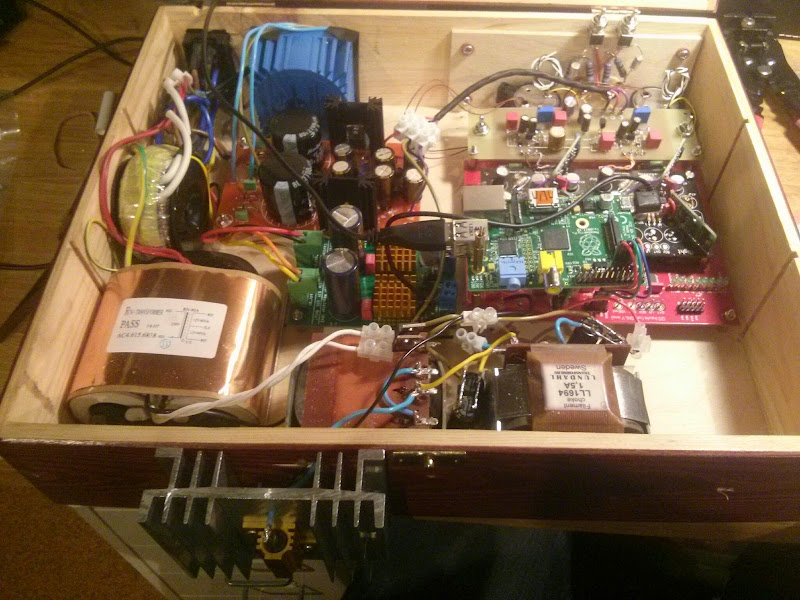
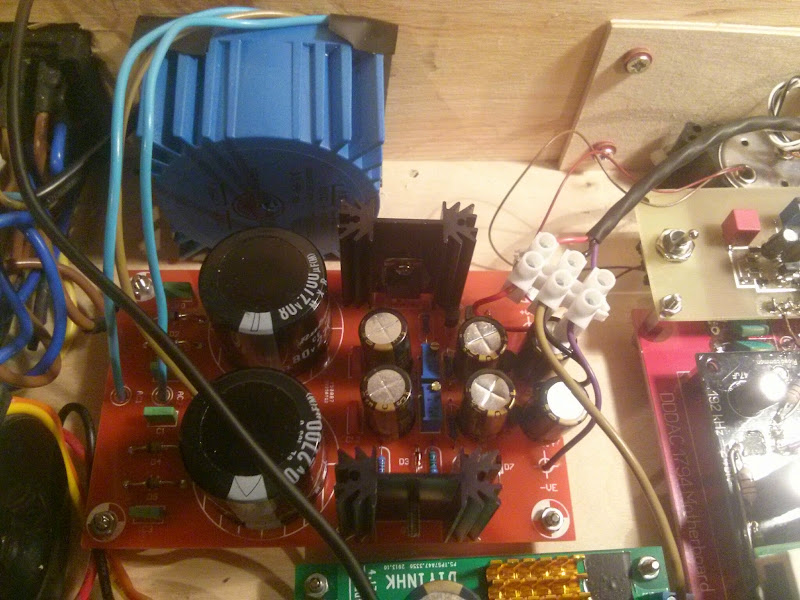
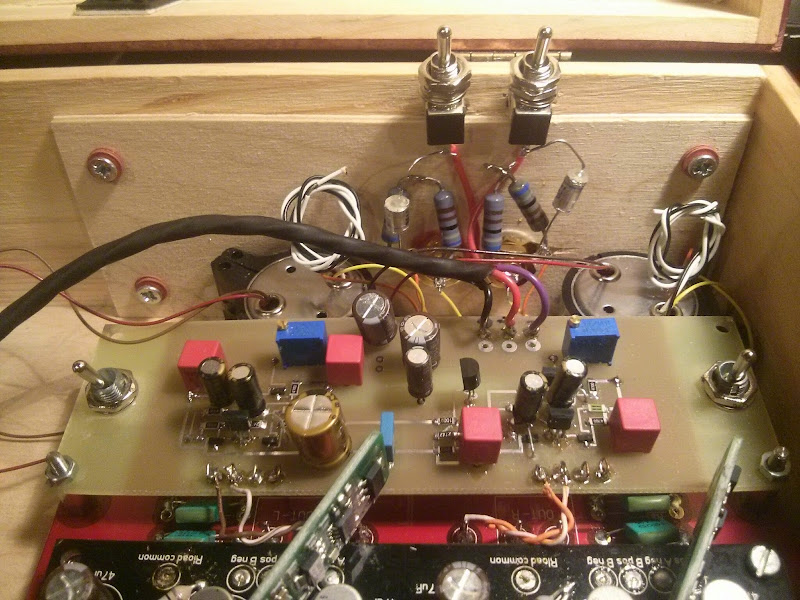
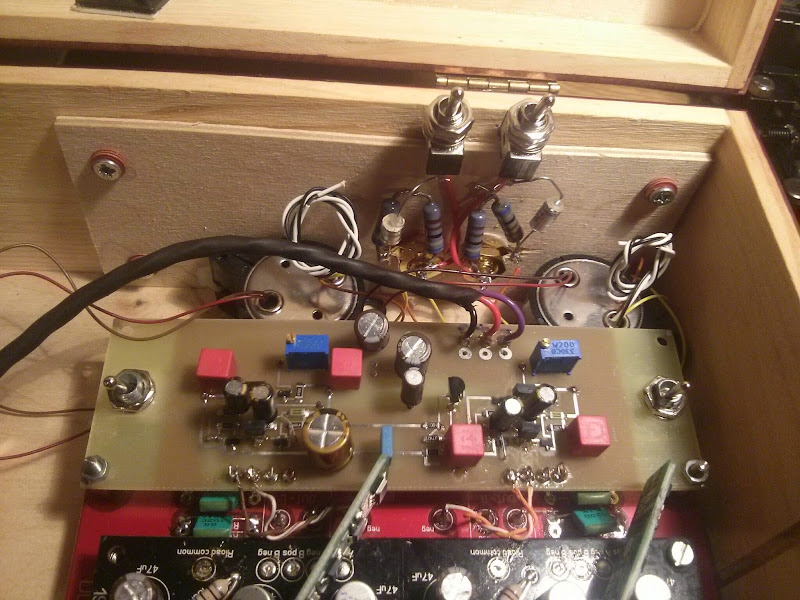
And wow! 😀
We heard about 3 hours of music last night comparing the details and characteristics and it's really changed my opinion of the buffer stage.
The slight ghosting/chorus I was hearing with the buffer is now gone with the caps in place. With the buffer now, the sound is more luscious, chunky and confident, which I was kind of expecting, but there is also a different level of detail. Certain vocal elements I find a touch edgey with just the dddac > cinemags feel smooth and relaxing with the dddac > buffer > cinemags > caps but not because of less detail. It feels like there's a bit more ambience coming across and some recordings felt more like I was at a performance using the buffer and caps than without.
Previously with the buffer, but without these new caps in place, it felt fatter, but gave the impression the dddac > cinemags direct was more airy and natural sounding, even if it was a touch thinner. Now with the caps, this isn't the case any more.
So I'm very happy with this solution now and I'd be glad for others to hear it if there's a way to hook up?
Is it the perfect solution? There's a very slight narrowing of the sound stage with the caps in place, but Ross tells me that reducing this to 150pf in his system has had the same positive effect without this negative, so I've got some 150pf caps on the way to me now and I'm excited to hear the results.
One thing we didn't test, which I would urge others to have a go with, is whether adding this 150pf cap (something like a WIMA FKP 3 or 2 is ideal) across the RCAs/outputs of the Cinemags has a similar positive effect for people not using a buffer stage and just running Cinemags direct from their dddac.
Got to be worth a try for the few pence and a couple of minutes soldering, surely?
I'm sure Ross can explain the technical details better than me, but that's where I'm up to right now, and it's a very nice place to be 🙂
Just to recap, I'm currently running e-301 current regulator diodes to pin 20, and I've been investigating running a jfet buffer stage inbetween my single deck pos/neg outputs and a pair of Cinemag output transformers.
I've installed switches, so I can instantly change the output from 'dddac > buffer > cinemags' to 'dddac > cinemags' so I can do some proper comparative listening.
My first impressions once the buffer stage had time to burn in and settle down were mostly positive, but not entirely. The sound was chunky, bold and luscious, but on certain recordings there was an additional ghosting which sounded almost like a very slight chorus effect. I wasn't happy that this was originally in the recording and felt that the buffer had added something, which kind of put me off it a bit.
I've been chatting with Ross who's been incredibly helpful and having found specific sections of music that seemed to excite this behaviour, he dug his scope out and began breaking the issue down. Square wave signal into the buffer gave square wave out of the buffer, but not so with the cinemags, where the same signal exited looking quite scruffy.
Ross tried a small film capacitor across the output of the Cinemags and this cleaned the signal up very nicely, but go too large and it effected the music.
I joined in on this with a 220pf Polystyrene cap across my RCAs (as that's what I had to hand), which I have again installed with switches, so I can compare.
Here's a couple of pics of where I'm up to:




And wow! 😀
We heard about 3 hours of music last night comparing the details and characteristics and it's really changed my opinion of the buffer stage.
The slight ghosting/chorus I was hearing with the buffer is now gone with the caps in place. With the buffer now, the sound is more luscious, chunky and confident, which I was kind of expecting, but there is also a different level of detail. Certain vocal elements I find a touch edgey with just the dddac > cinemags feel smooth and relaxing with the dddac > buffer > cinemags > caps but not because of less detail. It feels like there's a bit more ambience coming across and some recordings felt more like I was at a performance using the buffer and caps than without.
Previously with the buffer, but without these new caps in place, it felt fatter, but gave the impression the dddac > cinemags direct was more airy and natural sounding, even if it was a touch thinner. Now with the caps, this isn't the case any more.
So I'm very happy with this solution now and I'd be glad for others to hear it if there's a way to hook up?
Is it the perfect solution? There's a very slight narrowing of the sound stage with the caps in place, but Ross tells me that reducing this to 150pf in his system has had the same positive effect without this negative, so I've got some 150pf caps on the way to me now and I'm excited to hear the results.
One thing we didn't test, which I would urge others to have a go with, is whether adding this 150pf cap (something like a WIMA FKP 3 or 2 is ideal) across the RCAs/outputs of the Cinemags has a similar positive effect for people not using a buffer stage and just running Cinemags direct from their dddac.
Got to be worth a try for the few pence and a couple of minutes soldering, surely?
I'm sure Ross can explain the technical details better than me, but that's where I'm up to right now, and it's a very nice place to be 🙂
cap across secondary - tuning of exact source-xformer combo
that means different cap value for buffer-xformer vs. I/V resistor-xformer iterations
that means different cap value for buffer-xformer vs. I/V resistor-xformer iterations
Very nice James 🙂
______________________________________________
Is there something special about the left channel ??
Today I have received a brand new deck.
I stuffed the board ASAP as I'm musicless for 2 weeks or so (sudden faulty left channel after 2*10 Ohm and 2*10uH removal).
I double checked every solder joint, as usual.
Once plugged, I measured some voltages : the left channel is still non functionning. Yes, on the brand new PCB !
Voltages out of the Belleson regulators on the right channel are perfect and stable.
On the left side, I've got the same weird behaviour : about 1.2V out of the 3.3 reg and say 3.6V out of the 8V. I think there's something wrong in the current draw, because I swapped those regs with spare ones, and with the ones running on the right side, result is the same.
So I've put back the two 10 Ohm resistor (removed after Brian Lowe's advice), and it's still the same.
So question is, is there something special on the left side, causing my problem on 2 different DAC decks ?
Is there anything in the mainboard that can cause this ?
I'm in a heavy brainstorming, but have not a damn clue. And I'm hearing a voice saying my DDDAC won't be up anymore
______________________________________________
Is there something special about the left channel ??
Today I have received a brand new deck.
I stuffed the board ASAP as I'm musicless for 2 weeks or so (sudden faulty left channel after 2*10 Ohm and 2*10uH removal).
I double checked every solder joint, as usual.
Once plugged, I measured some voltages : the left channel is still non functionning. Yes, on the brand new PCB !
Voltages out of the Belleson regulators on the right channel are perfect and stable.
On the left side, I've got the same weird behaviour : about 1.2V out of the 3.3 reg and say 3.6V out of the 8V. I think there's something wrong in the current draw, because I swapped those regs with spare ones, and with the ones running on the right side, result is the same.
So I've put back the two 10 Ohm resistor (removed after Brian Lowe's advice), and it's still the same.
So question is, is there something special on the left side, causing my problem on 2 different DAC decks ?
Is there anything in the mainboard that can cause this ?
I'm in a heavy brainstorming, but have not a damn clue. And I'm hearing a voice saying my DDDAC won't be up anymore
Hi James,
good and interesting feedback. Great you tuned your system that way. For any one else, do not just copy the 220pF or 150pF or what ever. The interlink after the DAC has similar capacitance... so this must always be a very individual tweak. Change cables and you would need a new compensation.
good and interesting feedback. Great you tuned your system that way. For any one else, do not just copy the 220pF or 150pF or what ever. The interlink after the DAC has similar capacitance... so this must always be a very individual tweak. Change cables and you would need a new compensation.
Very nice James 🙂
______________________________________________
Is there something special about the left channel ??
Today I have received a brand new deck.
I stuffed the board ASAP as I'm musicless for 2 weeks or so (sudden faulty left channel after 2*10 Ohm and 2*10uH removal).
I double checked every solder joint, as usual.
Once plugged, I measured some voltages : the left channel is still non functionning. Yes, on the brand new PCB !
Voltages out of the Belleson regulators on the right channel are perfect and stable.
On the left side, I've got the same weird behaviour : about 1.2V out of the 3.3 reg and say 3.6V out of the 8V. I think there's something wrong in the current draw, because I swapped those regs with spare ones, and with the ones running on the right side, result is the same.
So I've put back the two 10 Ohm resistor (removed after Brian Lowe's advice), and it's still the same.
So question is, is there something special on the left side, causing my problem on 2 different DAC decks ?
Is there anything in the mainboard that can cause this ?
I'm in a heavy brainstorming, but have not a damn clue. And I'm hearing a voice saying my DDDAC won't be up anymore
this seems to be a very Special Thing you are having here. Of course some Thing is causing this, most likely a short some where. Nothing to do with the main board it self. Have you tried the board without the Shunts? Just to go sure you have a working starting Point before putting Shunts on?
That is what I would do. step by step... see where things really go wrong.
I thaught about that, but how the hell can we harm them ?Logic chip one or more of the last 4 164's
this seems to be a very Special Thing you are having here. Of course some Thing is causing this, most likely a short some where. Nothing to do with the main board it self. Have you tried the board without the Shunts? Just to go sure you have a working starting Point before putting Shunts on?
That is what I would do. step by step... see where things really go wrong.
Step by step... I wish I were clever enough for that this afternoon.
I've almost destroyed the SMD regular regulators... so too late for that one.
And my unregulated PS puts around 14.5 VDC, so very close to the 15VDC limit of the SMD regs.
What do you think of the 2*10 Ohm and 2*10uH ? Is there any technical reason for the DAC not to work without them (that said, the right channel is always good, with and without) ?
Can I power the DAC without any input connected (no WaveIO, no SPDIF...) ?
One modification before the left channel stops was wiring the first choke in common mode. I'll try to change that, maybe a Thing is hidden there 😉
Last question, is it possible to have a short undetected by an average multimeter ?
Thanks.
I had the chance to listen to a Hugo Chord dac yesterday, with my own headphones and reference music. It’s being raved about by a nr of people over at Head-fi, as being the “best” theye’ve Heard, etc..
Well after having digested the experience and listing to my DDDAC for a bit move, I can honestly say the DDDAC beats the Hugo hands down. Really striking differences are the separation and placements and the much better dynamics, bass extension and detail/impact/weight & over all much more musical presentation. Maybe the Hugo has a slight edge on smoothness, but it’s hard to say if it is being more accurate and true to the recording in that respect.
Well after having digested the experience and listing to my DDDAC for a bit move, I can honestly say the DDDAC beats the Hugo hands down. Really striking differences are the separation and placements and the much better dynamics, bass extension and detail/impact/weight & over all much more musical presentation. Maybe the Hugo has a slight edge on smoothness, but it’s hard to say if it is being more accurate and true to the recording in that respect.
Hi Stijn,
Hugo Chord is also very popularly raved at this end of town. I personally haven't heard this particular just yet but I knew those have it has the tendency to pass it on. Unlike you, I have in my Man Cave right now is a loan "PS Audio DSD" with most updated software. It sounds pretty good but no way near my 11-Dac shunts Sowters with unregulated ps. There is, of course, the possibility of am being biased here, however, DDDAC sounds much more natural to me. DDDAC has the attributes of producing Excellent resolution sound imaging with depth whereas DSD sounds synthetic and lack of depth.
Phews! I glad I didn't go through the iteration of commercial DAC swapping pitfall.
Current am working on BBB with Acko Isolator & Re-Clocking 98.xx/90.xx via Miero's Botic driver after been a little impatient with Botic Cape. Learning Linux on the fly here! 😀
Chanh
Hugo Chord is also very popularly raved at this end of town. I personally haven't heard this particular just yet but I knew those have it has the tendency to pass it on. Unlike you, I have in my Man Cave right now is a loan "PS Audio DSD" with most updated software. It sounds pretty good but no way near my 11-Dac shunts Sowters with unregulated ps. There is, of course, the possibility of am being biased here, however, DDDAC sounds much more natural to me. DDDAC has the attributes of producing Excellent resolution sound imaging with depth whereas DSD sounds synthetic and lack of depth.
Phews! I glad I didn't go through the iteration of commercial DAC swapping pitfall.
Current am working on BBB with Acko Isolator & Re-Clocking 98.xx/90.xx via Miero's Botic driver after been a little impatient with Botic Cape. Learning Linux on the fly here! 😀
Chanh
something funny about the Hugo, initially it grabs your attention but it has an edgy sound and then after a while lose interest in its sound
maybe its all the functions having an adverse effect
still a fine dac though
maybe its all the functions having an adverse effect
still a fine dac though
I had the chance to listen to a Hugo Chord dac yesterday, with my own headphones and reference music. It’s being raved about by a nr of people over at Head-fi, as being the “best” theye’ve Heard, etc..
Well after having digested the experience and listing to my DDDAC for a bit move, I can honestly say the DDDAC beats the Hugo hands down. Really striking differences are the separation and placements and the much better dynamics, bass extension and detail/impact/weight & over all much more musical presentation. Maybe the Hugo has a slight edge on smoothness, but it’s hard to say if it is being more accurate and true to the recording in that respect.
Hi Stijn,
We are using some of the best DAC's available! I know from experience (at Stefan's place) the DDDAC is something special (and can even be made better by "tuning" it), I like what my AN DAC 4.1X is doing, (and also "tuned" it after that time) but also liked the "Stefan modded" DDDAC a lot.
What did you do with your DDDAC since that time? Did you make it similar to Stefan's?
I also looked into the Chord Hugo quite a lot some time ago, but I already gave up on it a bit later... 😉
Mark.
2-Chip 1/2 Clock Delay - Recommended!
It works! See pictures below. Took about 4 hours total to build and install.
I hear MORE music!
- Cymbals sound 100% right for the first time.
- Voices are more articulate
- Sound is more crisp and vibrant. This makes sense if any mishandling of bits results in the blunting of music. Some of this may be new parts sound. No smoothing here.
- Same amount of detail, but it sounds more coherent and "right"
- I got drawn into musical nuances of familiar CDs that I never noticed before.
- More focused placement of instruments in the soundstage. You can almost hear the size and shape of instruments.
The board is about $6 usd of parts, but I had to buy a 5V Belleson SPM78 regulator ($36). The 100 and 1000 ohm I2S resistors were replaced with jumpers. The bottom of the main board had to be modified by cutting BCK foil traces and adding jumpers. You can see the delayed signal wire from the 2-Chip Board coming through one of the clock foil trace holes to the five 74VHC164 chips.
It is possible to design a "tweak" board the size of the DAC board that would stack on top of it. The board could include a buffer circuit, 2-chip 1/2 clock delay circuit and several CCS mini-boards that could be used in place for one DAC or cut out for experimentation or use on multiple DACs. Any interest?
It works! See pictures below. Took about 4 hours total to build and install.
I hear MORE music!
- Cymbals sound 100% right for the first time.
- Voices are more articulate
- Sound is more crisp and vibrant. This makes sense if any mishandling of bits results in the blunting of music. Some of this may be new parts sound. No smoothing here.
- Same amount of detail, but it sounds more coherent and "right"
- I got drawn into musical nuances of familiar CDs that I never noticed before.
- More focused placement of instruments in the soundstage. You can almost hear the size and shape of instruments.
The board is about $6 usd of parts, but I had to buy a 5V Belleson SPM78 regulator ($36). The 100 and 1000 ohm I2S resistors were replaced with jumpers. The bottom of the main board had to be modified by cutting BCK foil traces and adding jumpers. You can see the delayed signal wire from the 2-Chip Board coming through one of the clock foil trace holes to the five 74VHC164 chips.
It is possible to design a "tweak" board the size of the DAC board that would stack on top of it. The board could include a buffer circuit, 2-chip 1/2 clock delay circuit and several CCS mini-boards that could be used in place for one DAC or cut out for experimentation or use on multiple DACs. Any interest?
Attachments
Yes that's my experience too
a must for all red mainboards
Runs fine from 3.3v either
Tidier job than my first attempt
Oh tried 2sk170gr and lsk170 today for ccs
The 2sk170gr has a monumentally low noise floor compared to the lm334
But lacks detail definition and dynamics that the lm334 had
The lsk170 is a compromise between them but their must be something better?
That noise floor is really something
The 2sk170gr need circa 1.5kohm to set and the lsk170 needed 300 ohm
a must for all red mainboards
Runs fine from 3.3v either
Tidier job than my first attempt
Oh tried 2sk170gr and lsk170 today for ccs
The 2sk170gr has a monumentally low noise floor compared to the lm334
But lacks detail definition and dynamics that the lm334 had
The lsk170 is a compromise between them but their must be something better?
That noise floor is really something
The 2sk170gr need circa 1.5kohm to set and the lsk170 needed 300 ohm
Last edited:
More JFET CCS tests
Nige2000,
Did you actually listen to the lm334 in your DAC? In mine it had less detail than the 2SK170 and sounded unmusical. To me it was unlistenable.
I just got a dozen 2SK246Y JFETs today. The Idss ranges from 1.79 to 2.70ma at 9VDC. I further tested 2.05ma and 2.43ma Idss 2SK246Y JFETs and measured a Voltage drop through source resistance of 2034 and 2480 ohms of 0.867V and 1.011V at 0.4ma. Plenty of Voltage left for Vds to provide constant current control. Tomorrow I will do a signal test on a scope and build a couple of CCS boards to listen to.
The best news for the 2SK246Y is temperature stability. The current drops only about 2-3% as I heat it past 40C. The DAC stack clan can adjust these cold to 0.41ma and then forget about them. By contrast, the 2SK170 quickly climbs past 0.50ma as I heat it up.
Nige2000,
Did you actually listen to the lm334 in your DAC? In mine it had less detail than the 2SK170 and sounded unmusical. To me it was unlistenable.
I just got a dozen 2SK246Y JFETs today. The Idss ranges from 1.79 to 2.70ma at 9VDC. I further tested 2.05ma and 2.43ma Idss 2SK246Y JFETs and measured a Voltage drop through source resistance of 2034 and 2480 ohms of 0.867V and 1.011V at 0.4ma. Plenty of Voltage left for Vds to provide constant current control. Tomorrow I will do a signal test on a scope and build a couple of CCS boards to listen to.
The best news for the 2SK246Y is temperature stability. The current drops only about 2-3% as I heat it past 40C. The DAC stack clan can adjust these cold to 0.41ma and then forget about them. By contrast, the 2SK170 quickly climbs past 0.50ma as I heat it up.
I can hear why you say lm334 is unlistenable it's clearly not right for the job, but I do think it did something better too
Hi Mark, good to hear from you. Yes I more or less caught up with Stefan's design, who himself changed his setup again after we listened to it. I personally have hand picked a slightly different cap scheme and used some additional HF filter caps etc..
Yes that's my experience too
a must for all red mainboards
Does the newer mainboard not need this /already have this mod then?
David
- Home
- Source & Line
- Digital Line Level
- A NOS 192/24 DAC with the PCM1794 (and WaveIO USB input)
